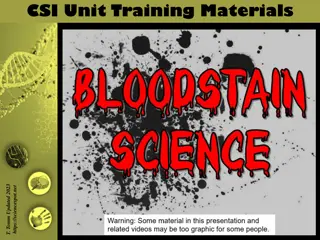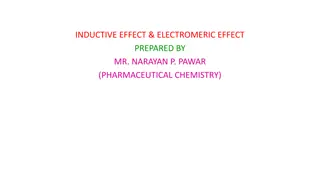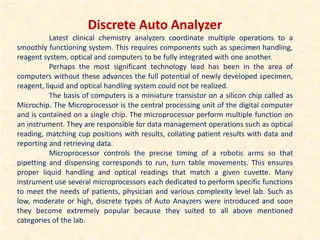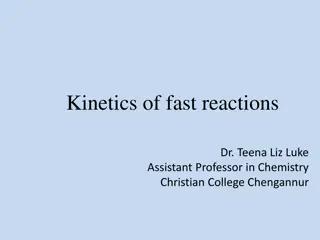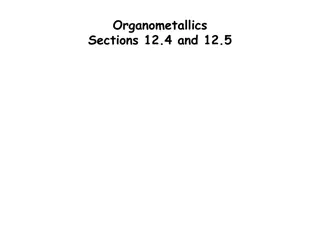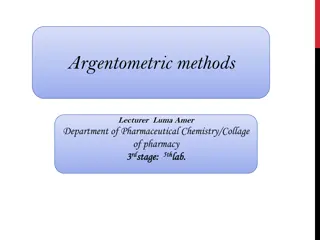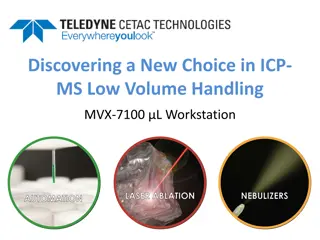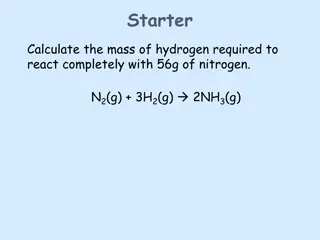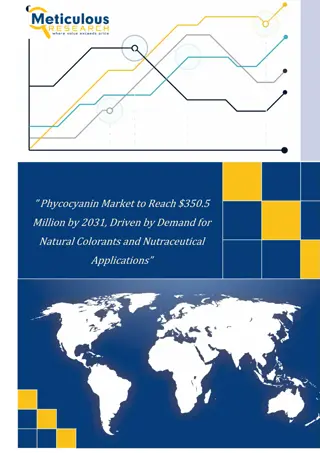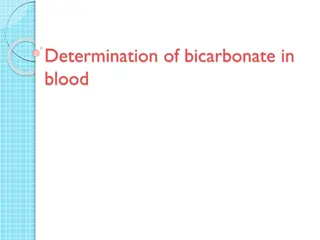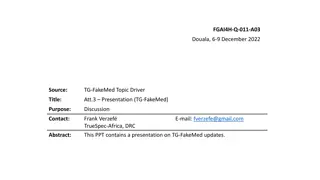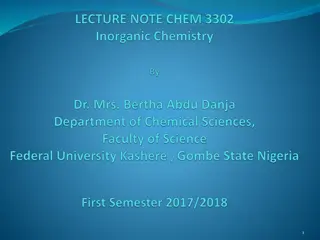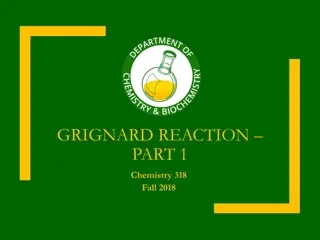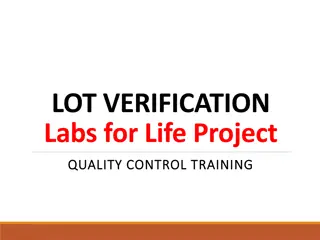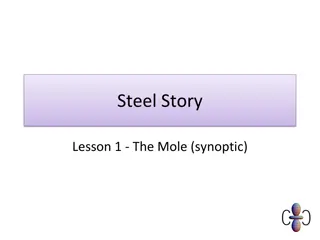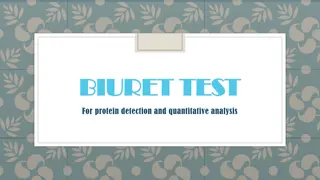Reagent Preparation for Food Analysis: Barfoed's and Seliwanoff's Tests
Preparation of reagents such as Barfoed's reagent and Seliwanoff's reagent is essential for detecting monosaccharides in food analysis. Barfoed's test utilizes a mixture of acetic acid and copper(II) acetate to detect reducing sugars, while Seliwanoff's reagent helps identify ketoses in solutions. U
2 views • 19 slides
Protein Assays Market
Protein Assays Market by Type (Dye-based, Copper-based) Technology (Fluorescence, Absorbance, Colorimetric) Offering (Reagent, Kit, Instrument) Application (R&D, Drug Discovery, Diagnostics) End User (Pharmaceutical, Hospital) \u2013 Global Forecast to 2031\n
2 views • 4 slides
Molecular Diagnostics Market Projected to Reach $46.69 Billion by 2030
Molecular Diagnostics Market by Product (Reagent & Kits, Systems, Software), Test Type (Lab, PoC), Technology (PCR, ISH, INAAT, Sequencing, Microarray), Application (Infectious Diseases, Oncology), End User (Hospital, Diagnostic Lab)
8 views • 2 slides
Bloodstain Pattern Analysis: Training Materials and Techniques
Explore the fundamentals of bloodstain pattern analysis through interactive training materials covering topics such as BPA representation, types of blood patterns, droplet analysis, and more. Discover how investigators learn crucial details from blood spatter, including types of injuries, weapon inf
1 views • 21 slides
Understanding the Inductive and Electromeric Effects in Organic Chemistry
The inductive effect in organic chemistry is the polarization of a bond due to electron-donating or withdrawing effects of adjacent groups, leading to a degree of polarity in the bond. This effect is distance-dependent and can be either electron-withdrawing or electron-releasing. On the other hand,
0 views • 12 slides
Advancements in Discrete Auto Analyzers for Clinical Chemistry Operations
Discrete auto analyzers integrate specimen handling, reagent systems, optical components, and computers for streamlined functionality. The innovation in computer technology, particularly microprocessors, has revolutionized these analyzers, enabling precise data management, liquid handling, and optic
0 views • 17 slides
Back Titration in Analytical Chemistry
Back titration is a technique used in analytical chemistry to determine the concentration of an analyte by reacting it with an excess of another reagent first, followed by titration of the excess reactant. This method is especially useful in cases where direct titration endpoints are difficult to di
2 views • 14 slides
MTT Cell Proliferation Assay: Protocol and Applications
The MTT cell proliferation assay is a widely used technique to measure cell viability, proliferation, and cytotoxicity in research. This colorimetric assay involves the conversion of MTT reagent to formazan dye by live cells, resulting in a purple color change. This comprehensive guide provides step
0 views • 8 slides
Understanding the Kinetics of Fast Reactions in Chemistry
Kinetic methods involve measuring analytical signals under dynamic conditions to study fast reactions in chemistry. This study explores the various methods used, such as Flow Method and Stopped Flow Method, to determine reaction rates accurately. Advantages of the Stopped Flow Method over Continuous
0 views • 18 slides
Exploring the Fascinating World of Grignard Reagent in Organometallic Chemistry
Delve into the significance of the Grignard Reagent, a pivotal discovery honored with the Nobel Prize in Chemistry in 1912 for its transformative impact on organic chemistry. Unveil the versatile applications and reactions of this essential reagent, showcasing its ability to react with various subst
0 views • 42 slides
Understanding Argentometric Methods in Pharmaceutical Chemistry
Argentometric methods, as taught by Lecturer Luma Amer from the Department of Pharmaceutical Chemistry at the College of Pharmacy, involve titrations using silver-based compounds like silver nitrate. These methods have limitations due to co-precipitation effects and limited indicator choices. Parame
0 views • 14 slides
Discovering a New Choice in ICP-MS Low Volume Handling: MVX-7100 Workstation Automation
Explore the MVX-7100 workstation for ICP-MS low-volume handling, offering features like reduced reagent usage, well plate compatibility, sample mixing, and more. Addressing challenges of working with small sample sizes at trace levels, this system provides automation options and is supported by rese
0 views • 33 slides
Calculating Limiting Reagent in Chemical Reactions
Calculating the amount of reactants in excess and the limiting reagent plays a crucial role in determining the maximum extent of a chemical reaction. By using the relative numbers of moles of substances as shown in balanced equations, one can identify the reactant that is fully utilized, hence limit
0 views • 14 slides
Phycocyanin Market to Reach $350.5 Million by 2031, Driven by Demand for Natural Colorants and Nutraceutical Applications
Phycocyanin Market Size, Share, Forecast, & Trends Analysis by Form (Powder, Liquid), Grade (Food-grade, Reagent grade, Cosmetic-grade Phycocyanin), Category (Non-Organic, Organic), Application (Food & Beverages, Pharmaceuticals)\u2014Global Forecast
0 views • 5 slides
Determination of Bicarbonate in Blood Using Back Titration
Back titration is an analytical chemistry technique used to determine the concentration of an analyte, such as bicarbonate in blood. This method involves reacting the analyte with an excess reagent, followed by back-titrating the remaining excess and relating it to the original sample's concentratio
0 views • 21 slides
Advancements in Drug Testing and Quality Control in Africa
This presentation discusses the use of near-infrared (NIR) spectral methods for rapid and reagent-free drug testing in Africa. The focus is on deploying low-cost infrared devices for verifying medicines, building databases on genuine medicines, and enhancing the capacities of drug professionals thro
0 views • 12 slides
Insights into Hydrogen: Properties, Reactions, and Applications
Discover the key properties, preparation methods, and isotopic composition of hydrogen. From its role as the most abundant element in the universe to its use as a powerful reducing agent and industrial reagent, explore the diverse characteristics and applications of this versatile element. Learn abo
0 views • 87 slides
Grignard Reaction in Chemistry Lab: Part 1 Overview
The Grignard Reaction Part 1 in Chemistry 318 Fall 2018 involves the preparation of the Grignard reagent, its reaction with CO2, and the isolation of the benzoic acid product. The experiment spans two lab sessions, focusing on safety precautions, pre-lab checks, and upcoming due dates. Students are
0 views • 11 slides
Quality Control Training for Labs: Ensuring Reagent and Consumable Quality
This project focuses on maintaining quality control in laboratories by verifying reagents and consumables, adhering to ISO and NABL standards. It includes checking and verifying each lot of control and reagent, assessing transportation factors, monitoring temperature control, and performing lot-to-l
0 views • 13 slides
Understanding the Mole Concept in Chemistry
Explore the fundamentals of the mole concept in chemistry, including calculations involving molecular formulas, reagent masses, percentage yields, gas volumes, concentrations, and balanced chemical equations. Learn about the definition of a mole, calculating the number of moles, and converting mass
0 views • 23 slides
Understanding Biuret Test for Protein Detection
The Biuret Test is a method used to detect the presence of proteins by identifying peptide bonds, which form the basis of protein structure. By utilizing a specific Biuret reagent, proteins can be quantitatively analyzed based on the color change observed. The test relies on the reaction between cop
0 views • 7 slides



